|

Registered
Office
University College London, Institute of Archaeology, 31-34 Gordon Square,
London WC1H 0PY
NUMBER 28 APRIL 1998
|
|
|
|
STANTON
DREW
Although it received wide press coverage, the
results of the new survey at Stanton Drew were far too interesting for
PAST to leave them to Fleet Street so we persuaded Andrew David to write
our front-page piece.
|
|
Despite the fact that the megalithic stone settings at Stanton Drew were commented upon by both Aubrey and Stukeley, and
by many others thereafter, it is very remarkable that they have remained so little explored. The stone circles are under the protection of English Heritage and, having recently come into new ownership, allowed the possibility of negotiating improved access and management. In order to undertake this from a more informed background a geophysical survey was commissioned from the Ancient Monuments Laboratory. The need for such a survey had already been highlighted by the Avon Archaeological Unit as part of a proposed project to re-evaluate the site. Currently, a Conservation Plan is being drafted by the Stanton Drew Steering Committee which comprises representatives from the local authority (Bath and NE Somerset), the University of Bristol, the Avon Archaeological Unit and English Heritage.
|
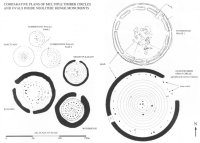
Figure 1
|
The startling outcome of the 1997 geophysical survey, reported below, has received wide attention and Stanton Drew has been billed in the press as 'rivalling' Stonehenge - a comparison not invited lightly.
The main discoveries relate to the largest feature of the megalithic complex - the Great Circle, which, at 113m in diameter, is the largest British stone circle after Avebury. Magnetometer survey using fluxgate instruments, adapted so that the sensors were carried as close to the ground as possible, revealed that the stone circle was but one element in a much more elaborate arrangement of concentric features (Fig 2). The stones themselves were found to be encircled by a 5-7m wide henge ditch with an unusually wide (50m) gap facing to the NE. Within the stone circle were the traces of concentric rings, with a cluster of magnetic anomalies at their centre.
Some 40m from the Great Circle, within the smaller NE stone circle, the magnetometer located four central anomalies arranged in a quadrilateral, the sides of which align with the four opposed pairs of stones that make up the circle. These anomalies might be responses to hearths but are more probably caused by pits - perhaps the remnants of a former stone or timber setting. Other anomalies seem to flank a passage or avenue leading from this central feature to the NE, a direction maintained by the megalithic avenue that extends outwards from the circle.
|
|
In order to enhance
the definition of the extremely weakly magnetised features within the
Great Circle, the area was resurveyed using a more sensitive magnetometer
of the optically pumped caesium variety. The results, illustrated here
(Fig 3) confirm the presence of no less than nine concentric rings.
The increased resolution of the survey data (collected at 0.5m x 0.12m
intervals) provides the clear impression that the rings are each made
up of a series of discrete positive magnetic anomalies. These are most
obvious in the outer ring, less so in the others, although the eye has
a knack of grasping the broader pattern despite the indistinctiveness
of its parts. The rings seem to be composed of circles of pits of over
a metre in diameter and separated from one another by gaps of about
1m.
Having set aside the
outside possibilities that these patterns might be the result of cultivation
or even the construction of a post-medieval maze, it becomes an irresistible
assumption, fired by comparison with sites such as The Sanctuary, Woodhenge
and Durrington Walls, that the pits are integral with the prehistoric
site and once held timber uprights. Of course this cannot yet be proven
nor is any relative constructional sequence apparent. The structure(s)
at Stanton Drew stand apart on account of their colossal size (Fig 1):
the diameters of the inner and outer circles are 23m and 95m respectively.
If not hearths, cremation
pits, or some other type of pit (cf the Aubrey Holes at Stonehenge),
the presence of locally increased magnetic susceptibility could be explained
by the burning of posts in situ. More speculatively, we have suggested
that the magnetic enhancement may be due instead to the accumulation
of biogenic magnetite concentrated in the post pipes following the decay
of the timbers. The subsoil, derived from Keuper Marl, is sandy and
unconsolidated to a depth of at least 2 metres and the relative ease
with which deep pits can be dug into this might at least be a partial
explanation for the adoption of such a multitude of post settings.
At the centre of the
circles is a cluster of several anomalies which is difficult to interpret.
Whilst at least one of these is plausible as a prehistoric pit, a central
setting perhaps, others may instead be evidence for unrecorded antiquarian
digging.
These first results
will be followed up by further survey which will aim, if possible, to
provide more information from within the Great Circle. Here every attempt
will be made to clarify the pattern of concentric circles and of their
component pits, for instance in the southern area where they seem to
be obscured by a former field boundary. Such work might allow a more
confident appraisal of the possible presence of aisles or corridors
within the circles. A detailed topographic survey will also be necessary
for the geometry of the complex to be studied alongside the geophysical
data. This will determine, for instance, whether or not the various
concentric elements truly share a common geometric centre. The geophysical
survey will also be extended further afield, at least to explore the
SW stone circle and its environs. Resistivity survey at the site has
so far not been very informative, but this and other methods will be
persevered with.
|
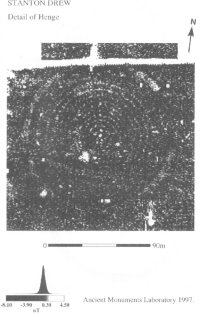
Figure 2
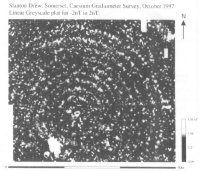
Figure 3
|
|
Andrew David
Ancient Monuments Laboratory
[From the Editor: take a look at the well-illustrated Web page discussing
the survey at
 |
http://www.eng-h.gov.uk/archaeometry/StantonDrew/ |
|
|
EDITORIAL
|
|
I hope that readers will respond to the invitation to debate the new interpretation of the 'sorcier' figure from Trois Frères, which I have summarised. The regular appearance of this newsletter facilitates the exchange of opinions on new ideas, and I look forward to receiving your contributions to the debate.
I would also like to encourage more reviews of both permanent and temporary exhibitions and presentations of prehistory like that supplied by Andrew Lawson of the Parc Pyrénéen de l'Art Préhistorique. They may entice us to visit (or not!) permanent presentations, and, in the case of temporary exhibitions with a short life, can tell us about what we may have had to miss. So next time you are in a prehistoric theme park, a 'heritage centre' or a museum, have some paper and a writing implement handy - if not an electronic notebook!
|
|
A
NEW HONORARY MEMBER: LADY AILEEN FOX
|
|
In January, at the joint Prehistoric Society - Devon Archaeological Society meeting in Exeter; past-President John Coles announced to the assembled audience that Council had recently elected Lady Aileen Fox as an Honorary Member of the Society, in recognition of her great contribution to the study of prehistory. On her retirement in 1972, after extensive fieldwork in the south-west of England (which, as Aileen pointed out, was not exclusively concerned with matters prehistoric), Aileen embarked on a second career in New Zealand, where she brought her skills and talents to bear on the study of Maori hillforts and artefacts. Her publications have been as prompt and pertinent as her fieldwork has been rewarding, continuing to the present with a new guide to hillforts in Devon and a paper in the Proceedings of the Devon Archaeological Society on recently-discovered tin ingots.
|
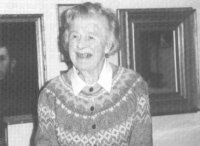
Lady Alieen Fox at the
Exeter Meeting
|
|
NEOLITHIC
CAUSEWAYED ENCLOSURES IN EUROPE
|
|
A major international conference is being organised jointly by the Royal Commission on the Historical Monuments of England and the Prehistoric Society to launch the RCHME's publication reviewing the causewayed enclosures of England. The conference is designed to present a review of recent work on these enclosures in mainland Europe, to complement the RCHME project and provide an overview of the current state of knowledge.
The conference organisers welcome offers of papers at either regional or national levels, which should preferably be illustrated. All papers should be presented in English, and the authors must be prepared to offer them for publication in the conference proceedings. The deadline for offers of papers is 30 October 1998. For further details please contact the conference organisers, Peter Topping, RCHME, 24 Brooklands Avenue, Cambridge CB2 2BU and Gillian Varndell, Dept of Prehistoric and Romano-British Antiquities, British Museum, Great Russell St, London WClB 3DG
|
|
EXCAVATIONS
AT TARA, COUNTY MEATH, IRELAND
Ireland's Discovery Programme again (see PAST
26) provides some exciting new data, this time from a well-known site
that has been previously excavated. As well as evidence for iron age
industrial activity, the excavation has revealed an imposing ditch which
challenges the accepted interpretation of such 'Royal' sites.
|
|
Excavation was carried out at Tara, County Meath during 1997 as part of the Discovery Programme's research projects. The objective of the excavation was to re-open two cuttings across the northern side of the large enclosure called Rath na Ríogh. This earthwork encompasses the summit of the hill and is defined by a ditch and external bank. The cuttings were excavated by Professor Sean P. Ó. Ríordáin between 1952 and 1955. Due to his untimely death the results of the excavation were never published and unfortunately only a portion of the archive survives.
The objectives outlined in the research design were to re-open and extend both cuttings, and to record and sample the stratigraphy using modern methods to answer specific questions. The desired objectives were to date Rath na Ríogh, through artefacts and suitable material for radiocarbon dating, to clarify the relationship between the enclosure and a palisade trench which had been recorded on the interior of the ditch, and the retrieval of environmental evidence to provide background information on the flora, fauna and development of the site over time. The 1950's excavations had also revealed a black charcoal-rich layer which had been interpreted as being sealed by the bank of the enclosure. This layer contained metal slag and other material indicating industrial activity. It was an objective of the recent excavations to attempt to determine its exact position and nature.
|
|
The 1997 season's work was remarkably successful
and the evidence uncovered was much more extensive than had been anticipated.
What has now emerged is a sequence of activity which appears at this
preliminary stage to date mainly in the Iron Age. The earliest recognised
evidence (Ó. Ríordáin's black layer), was found and confirmed to be
sealed beneath the bank of the enclosure. Excavation revealed that the
source of this black, charcoal-rich layer was debris from a bowl furnace.
Throughout the layer and especially around the immediate area of the
furnace, quantities of iron slag, tuyère and crucible fragments, some
with bronze residue, bronze stems and droplets, were recovered, as well
as small iron objects which await conservation before identification.
The most interesting iron object found is a
complete socketed axe-head. Again it is necessary to wait for the conservation
of the object to be completed before positive identification and dating
can be carried out. Blue glass fragments were also found within the
charcoal-rich layer. Trenches, possibly the foundation trenches for
associated structures, post-holes and up to 200 stake-holes were also
revealed. The full extent of these features could not be excavated as
they continued beneath the unexcavated area of the bank. This non-ritual
evidence is an exciting new insight into Tara. The area of industrial
activity was sealed by an old sod layer; above which the bank of Rath
na Ríogh was constructed.
One of the most impressive features of this
year's work is the magnificently imposing nature of the ditch. Reaching
a depth of up to 3m and with the underlying bedrock stepped, it challenges
the generally accepted non-defensive nature of "Royal Sites" with their
internal ditches. Animal bones, including the articulated skeletons
of small animals, were found especially in the lower fill of the ditch.
A portion of a glass bracelet and a fragment of a bronze fibula were
also found low in the ditch fill.
|
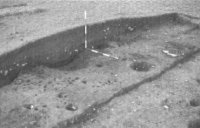
The Bowl Furnace in section
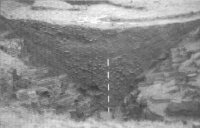
Section across the ditch
|
The palisade trench,
which contained post-pipes which would have held substantial upright posts,
revealed few finds except a few lumps of iron slag and a portion of an
unusual bracelet which appears to be made of stone. Stratigraphy suggests
that this trench is broadly contemporary with the construction of the
bank and ditch. However; an interesting feature of the trench suggests
that remodelling was carried out or that it had two phases of use.
It is anticipated that the full results of this season's excavation will be published in 1998, following the production of various specialists reports, including those on bone material, palaeoenvironmental evidence, metalworking and radiocarbon dating.
Helen Roche
Director – Tara Project, The Discovery Programme, 13/15 Lower Hatch Street, Dublin 2, Ireland
|
|
A
BIRMINGHAM RITUAL FOR AUBREY BURL
Byrony Coles reports on a secret well-kept.
|
|
In February, at a dinner held in Birmingham, Aubrey Burl was presented with a volume of essays written in his honour. The book, Prehistoric Ritual and Religion, has been edited by Alex Gibson and Derek Simpson, and some twenty of Aubrey's friends and colleagues have contributed papers on the themes of 'Monuments', 'Artefacts' and 'Theory and Practice'.
The Festschrift was kept secret from Aubrey until the very moment of presentation, and he has since commented on the chicanery of his friends and the devious deceit of his wife Judith, who had told him only that they were meeting Alex and Jane Gibson for a meal.
Aubrey survived the unexpected ordeal with grace and wit, attributes which also show clearly in his writing, as Alex Gibson illustrated with the following quote from Aubrey's Shire booklet on Prehistoric Henges:
"Today the interior [of the Muir of Ord] has been levelled for one of the greens on a golf course… As the players engage in the ritual of depositing a chalky white ball into a hole carefully positioned inside the henge, one wonders if they sense faint mocking laughter somewhere on the green".
|
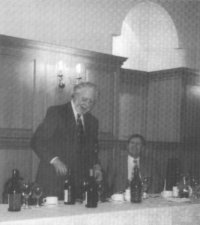
Aubrey Burl at the Festschrift
dinner in Birmingham, with Alex Gibson
|
|
BIRKSIDE
FELL RING CAIRN
Christopher Tolan-Smith updates us on the excavations
carried out with the aid of the Society's Leslie
Grinsell Award.
|
The first season of excavations at the Birkside Fell ring cairn in the North Pennines was reported on in PAST 25. Work at the site was completed in the summer of 1997 with the aid of the Society's 'Leslie Grinsell Award'. Apart from revealing the full structure of the cairn and providing information about the landscape in which it was built, the excavation led to the recovery of an excellently preserved Collared Urn containing about 2 kgs of cremated bone and a Hint knife. The urn, illustrated, may be attributed to the North Western Style of Longworth's Secondary Series. It stands 430 mm high and is 310 mm wide at the rim. The collar is decorated with infilled triangles executed with impressed, twisted cord while the neck is decorated with seven, roughly parallel, lines of individual impressions, probably made with a finger tip and finger nail. The internal bevel has three horizontal grooves. The urn had been placed in a tightly fitting pit slightly off-centre of the area enclosed by the circle of boulders identified in 1996. Collared Urns are rare finds in this part of northern England and the Birkside Fell vessel is a substantial addition to our knowledge.
|
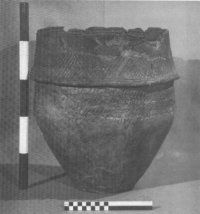
The Birkside Fell collared
urn
|
|
The cremated remains and associated charcoal are currently the subject of detailed study and it is hoped that the latter will provide radiocarbon dates for the vessel once identification has been completed. Preliminary analysis of pollen from the old ground surface indicates that the cairn, which is situated at 380 metres OD, was built in a largely open landscape. Continued excavation of the nearby Mesolithic site indicated that this part of the fell had been the focus of activities by communities living in the area over several thousand years.
Christopher Tolan-Smith
Department of Archaeology, University of Newcastle
|
|
A
LATER PREHISTORIC BURIAL AT WANLIP, LEICESTERSHIRE
Have PAST readers any suggestions or observations
of similar patterning that might help elucidate this piece of Iron Age
funerary archaeology?
|
|
A small rectangular cropmark site threatened by road construction was excavated in 1992/3 by Leicestershire Archaeological Unit, funded by the Department of Transport through English Heritage. The site comprised a much recut rectangular enclosure mostly devoid of internal features, with to the south and south-east various structures and pit groups. The pottery from the site is almost exclusively Iron Age, and interpretation of a radiocarbon programme has dated the site 450-350 BC.
An unurned cremation burial of a young adult was found in a shallow pit central to a rectangle formed by pits located to the south west of the enclosure. A radiocarbon date of 800-410 cal BC at 95½ confidence was obtained from oak charcoal from the cremation deposit (Camb.Q-3274). The cremation pit which cut earlier features was 0.40m by 0.35m and was up to 0.25m deep. The base of the pit was irregular with a socket on the south-west side, filled with a concentration of calcined bone.
|
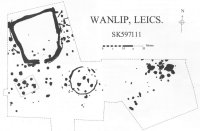
Excavation plan of the later
prehistoric settlement. The detailed plan of the cremation burial
is outlined.
|
The rectangle formed by the large pits may be a four post structure of perhaps two phases; the mostly obliterated first phase is best represented by pit 1165. Centres between pits were 6.7m east-west, and 4.5m north-south, a very near 3:2 ratio. Few functional clues existed within the internal stratigraphy of the corner pits although a concentration of large cobbles was found in the centre of pit 1393 towards its base and a circular patch of charcoal rich silt was found centrally at the base of pit 1081. These may be associated with post positions.
Further pits were recorded on the west and northern sides. The relationship between these and the corner pits of the structure is unclear; although there is an undoubted spatial relationship. They are slightly smaller than the corner pits and more commonly have breaks of slope on their edges which may suggest they were open for a period before infilling.
On the northern side, a shallow step, 1225, adjoined two similar intercutting pits, the earlier of which contained up to 2kg of pottery along with scorched and fire-cracked stone towards its base. A near complete jar appeared to have had been placed on the base of the cut against the western edge prior to backfilling.
|
Evidence of Iron Age funerary practice in the Fast Midlands is particularly scarce but the author can find no examples of similar date associated with such a large rectangular form in a national framework. Parallels for cremation burials of Late Iron Age date within square or rectangular structures are rare but not unknown - a recent example coming from Grave 20566 at Westhampnett, Sussex (Fitzpatrick 1997, 40) where an urned cremation lay centrally within a post formed square that itself was within a square ditched enclosure.
Analysis is nearly complete and it is hoped that publication of the site will appear in a forthcoming volume of Transactions of the Leicestershire Archaeological and Historical Society.
|
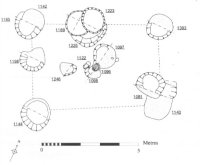
The unurned cremation burial
is context no 1096. An almost complete jar was found at the base of
pit no 1189.
|
|
Matthew Beamish
Project Officer
University of Leicester Archaeological Services
University Road
Leicester LE1 7RH
 |
MGB3@le.ac.uk |
References:
Fitzpatrick A.P. 1997 Archaeological Excavations on
the Route of the A27 Westhampnett Bypass, West Sussex, 1992. Vol 2:
The Late Iron Age, Romano-British, and Anglo-Saxon cemeteries Salisbury:
Trust for Wessex Archaeology
|
|
REVIEW
ARTICLE
This new section of PAST will bring short reviews
of a selection of the books sent for review to the Society. It does
not replace the review section in PPS, but will allow more books to
receive notice, and takes advantage of the thrice-yearly publication
of PAST for more rapid dissemination of book news.
|
|
Nine books - 1500 words to discuss them in. It's a bit like a TV competition cookery programme - prepare a three course meal in twenty minutes - Ready Steady Review!
Well, my first course inludes Cherry Lavell's Handbook for British and Irish Archaeology (Edinburgh University Press, 1997, £29.95, ISBN 0748607641) and John Prag and Richard Neave's Making Faces: Using Forensic and Archaeological Evidence (British Museum Press, 1997, £18.99, ISBN 0714117439).
Cherry Lavell was, for twenty five years, the editor of the CBA's British Archaeological Abstracts. In this volume she maintains the meticulous research standards of the Abstracts to produce a treasure house of a book. It is filled with the answers to most of the bibliographical and resource-related questions that might confront archaeological researchers. All major bibliographical sources are dealt with, there is also a section on 'Organisations, Institutions and Societies', and the whole thing is completed by a select, period/subject-based, bibliography. Internet and CD-ROM resources are also dealt with; this will be a crucial tool for all archaeologists.
Making Faces is a fascinating read. Anyone who has seen Julian Richards' television programme 'Meet the Ancestors' will appreciate the impact of this kind of forensic, facial re-creation. The book is unputdownable and charts the development of techniques and their application to the reconstruction of some famous archaeological faces from surviving skull remains. These include Philip II of Macedon, King Midas, and burials from grave circle B at Mycenae. I can't help feeling, though, that while it is such a good read it simply appeals to that little bit of the voyeur that is in all of us? We want to know what these people might have looked like (it brings them closer to us as individuals) - but what does it really contribute to broader archaeological knowledge?
This brings me to my main course of books with a 'landscape' theme. In The Human Uses of Caves (BAR 1997, Int. Sen 667, ISBN 0860548597), Bonsall and Tolan-Smith have produced the papers from a 1993 Newcastle conference. It is organised geographically and chronologically, dealing with prehistoric cave use in the 'Old World' from Portugal across to Eastern Europe, the Crimea, the Urals and the Caucasus, down to Israel, and to Southern Africa. Activity in Australia, Meso-America and Chile is also discussed. I was particularly interested (though I probably shouldn't say it here) in the historic/modern use of caves, especially by RomanoBritish craft specialists, recent Scottish travelling people, modern Croatian fisher-gatherers and contemporary Malawian secret societies.
Still with an international flavour Bernard Knapp in The Archaeology of Bronze Age Cypriot Society: The Study of Settlement, Survey and Landscape (Glasgow University, Dept of Archaeology, 1997, £12.50, ISBN 0852615736) and George Nash (ed.) Semiotics of Landscape: Archaeology of Mind (BAR, 1997, Int. Sen 661, ISBN 0860548546) both present post-processual/post-structural studies of various aspects of landscape archaeology.
Knapp has had a long term interest in prehistoric Cyprus and here he uses the concepts of 'landscape', 'settlement patterns' and the existence of planned settlements with specialised architecture, to examine social dynamics and political organisation in the island's Later Bronze Age. The book moves from a discussion of theoretical approaches to settlement archaeology and landscapes through a study of settlement archaeology in western Asia and the Mediterranean areas, to four chapters that deal with the archaeology of Cyprus. Along the way Knapp discusses problems of the archaeological record, recent survey results, and models for the development of the Bronze Age elite. He also challenges accepted views about social and political developments in the Cypriot Protohistoric Bronze Age. Knapp's theoretical synthesis would be a good starting place for undergraduates and others interested in recent debates. This is a concise, clearly written study which should certainly be of interest to non-Mediterranean specialists.
Semiotics of Landscape is a totally different beast. Here George Nash brings together ten papers from a 1994 TAG Conference session on the social construction of the landscape. The book deals, geographically, with Hungary, Spain, France, Britain, Germany and Denmark. Papers build on, among other things, symbolic and structuralist approaches to monuments (eg Nash on Welsh chambered tombs), notions of time and a sense of place (eg (Chapman on settlement in Eastern Hungary), Heideggerian, phenomenologiocal, approaches to 'human-being-in the-world' (eg Kirk on the Neolithic long mound of La Commune-Seche in Normandy) and radical constructivism (eg Holtorf on (Christian landscapes of pagan monuments in Britain and Brittany). The book is eclectic and obviously the end product of a TAG session, but it does present some refreshing new approaches to monumentality and landscape studies and it highlights the fact that archaeologists are continuously involved in re-interpreting the data available to them as they struggle to make sense of the landscape features with which they work.
Two new books deal with western Britain. Graham Ritchie's edited volume The Archaeology of Argyll (Edinburgh University Press, 1997, £17.95, ISBN 0748606459), is a composite, multi-period survey, synthesising results from RCAHMS's regional Inventories and current, unpublished research. Eleven chapters deal with Argyll's archaeology up to the Norse settlement, and it is a masterly review. I was impressed with Bonsall's chapter on the 'Obanian Problem', Ritchie's surveys of early settlement data and burial and ritual sites and MacKie's spirited defence of his interpretation of Dun Mor Vaul. The book is a scholarly, yet accessible text, enhanced by excellent illustrations.
In The Neolithic Culture of the Isle of Man: A study of the sites and pottery (BAR, Brit. Ser., 263, 1997, ISBN 0860548724) Stephen Burrow presents results from his Bournemouth University PhD. The book follows the standard BAR pattern of a discussion accompanied by a detailed corpus of data, and it is largely concerned with establishing a revised chronology and periodisation for the island's Neolithic. At this level I found the discussion disappointing. The review and collation of old and new data, much of the latter from the Bournemouth University field project on Man, is a model of clarity, but much more could, and should, have been done with it in terms of reconstructing social patterns and social change over time. The two appendices dealing with 'sites' and pottery assemblages are an important source of illustrative information, and both are produced to a high standard. I have always thought that one of BAR's most important services was to allow authors to present detailed catalogues of data that would not be published elsewhere. This done though, it is to be hoped that Burrow will go on, in future publications, to present his views on the social side of the Manx Neolithic.
The last offering in my main course is another BAR volume with a huge title but covering a very specific topic. William Boismier's Modelling the Effects of Tillage Processes on Artefactual Distributions in the Plough Zone: A simulation Study of Tillage-Induced Pattern Formation (BAR, Brit. Ser., 259, 1997, ISBN 0860548600) is a real piece of Middle Range research. Boismier is interested in understanding whether observed patterning in field walking data is 'real' or whether it is simply the end product of 'site' destruction as a result of tillage. There are nineteen pages of general discussion and a further 251 present experimental data. In Ch. 2 Boismier discusses the movement of plough zone artefacts with reference to agricultural engineering studies. The bulk of the work deals with three experimental data sets from Blue Flake, Illinois, USA, and Butser Hill and the Cambridge University Farm Project in England. A battery of statistical tests and simulations is brought to bear on the collected data and the work casts much light on how 'real', past behaviour-related, patterns of data on field surfaces get transformed into spurious arrangements as a result of ploughing. Some may say that this is a complicated, and massive, glimpse of the obvious, but the important point about the book is that it actually begins to demonstrate how these changes come about in the long term, by gradual accretion. It is hard going (certainly for innumerate reviewers like this one!) but it has tried to put plough-zone formation studies on a firmer footing.
Finally, my pudding course is Burial and Society: The Chronological and Social Analysis of Archgaeological Burial Data edited by C.K. Jensen and K.H. Nielsen (Aarhus University Press, 1997 ISBN 72886862). Sixteen papers, dealing with Danish burial data from prehistory to the Christian era, are split into three sections within the book. These deal with theory and methodology and chronological and social case studies. The whole volume is a perfect illustration of the wide range of approaches to burial archaeology that are current in the region. Papers include discussions of Bronze Age chronological problems, Iron Age sacrifice, and family and kin group studies, Saxon and later weapon burials, Christian practices and the use of modern analogies in the study of burial monuments - a rich mixture indeed!
All of the above have been interesting books to discuss -.and done in 1500 words too!
* Where no price is given it was unavailable at the time of writing.
Dr. Rob Young
School of Archaeological Studies
Universtiy of Leicester
email: ry3@le.ac.uk
|
|
LE
PARC PYRÉNÉEN DE L'ART PRÉHISTORIQUE
|
|
Caves and rock shelters decorated over a 20,000 year period of the Upper Palaeolithic are among the most vulnerable sites in Europe. When thousands of visitors were allowed each day into the confined space of Lascaux, disaster threatened. Fortunately, this was averted: the cave was closed, equilibrium restored, and the paintings saved. However; such a necessary conservation measure brought disappointment to those who could no longer experience the visual impact of the art.
|
In 1983, twenty years after the closure of Lascaux a facsimile was opened. Lascaux II is not, as its name may suggest, like a hackneyed Hollywood film sequel but is a brilliant success. Visitors (nearly 300,000 each year) experience the atmospheric descent into subterranean darkness and the vivid spectacle of the painted ceilings, while the financial contribution from tourism has re-invigorated the local economy.
Concern for all other painted caves and rock-shelters persists and as pressure mounts for the closure of more sites, there is considerable scope to emulate the Lascaux solution. Périgord is well furnished with museums, theme-parks, the excellent interpretation centre at Pech Merle, as well as the Lascaux facsimile itself, but other areas with concentrations of decorated caves have not been as well served. Now, for those drawn by the natural splendour of the Pyrenees, there is the Parc Pyrénéen de l'Art Préhistorique outside Tarascon-sur-Ariège, situated in an area with a dozen painted caves including the great cave of Niaux.
Motoring southward from Toulouse on the N20, the flat outwash plain drained by tributaries of the Garonne is dramatically broken at Foix as the Pyrenees spring skyward. Ten kilometres further; Tarascon is situated at the entrance to the Ariège gorge, surrounded by jagged peaks and swirling clouds. In this awesome setting, the Parc Pyrénéen blends elements of the semi-natural landscape with modern facilities. Streams feed artificial lakes and waterfalls. Paths lead across stepping stones and beneath cascading water as it descends from pool to pool through native woodland and mountain pasture. Modern sculptures, a picnic area with kiosk, and purpose built pavilions with sound, music and painted panoramas are all part of the learning experience. The park is a bold joint venture between the Conseil Général de l'Ariège and Crédit Agricole Sud Meditarranée, guided by a scientific committee under the chairmanship of Jean Clottes. Its purpose is unashamedly to stimulate interest and understanding of palaeolithic ways of life while deflecting pressure from genuine sites, and is carefully devised to offer enjoyment to visitors of all ages.
|
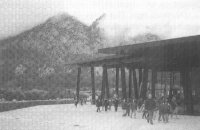
The interpretation centre with
the Pyrenees as a backdrop
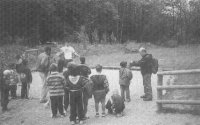
Instructions in the use of a
spear-thrower, with bison-shaped targets in the background
|
|
In one meadow, I came across a party of school children absorbed in the finer points of spear-throwing. After careful instruction each person could try their skills on a sort of firing range with bison shaped targets set at 40m intervals. Spear-throwers, which were ornately carved during the Upper Palaeolithic, were clearly an effective tool in the hunter's armoury, for I found that at the first attempt my spear flew (with admittedly wayward aim) over the 80m target. What a sense of achievement - an Olympic standard instantly!
|
A modern steel and glass building at the side of the park houses the restaurant, conference room, shop and Le Grand Atelier, the interpretation centre. The darkened galleries inside are designed to offer the ambience of a cave, while the subjects for study (footprints, engraving, symbols etc) are brightly lit. Large screens show filmed interviews with leading experts who explain scientific techniques, the philosophy of conservation, techniques of decoration and so on. Portable objects are suspended in individual cases allowing close examination. Best of all, a remote audio system monitors the position of each individual, so that wherever you are, you receive appropriate commentary in your chosen language (a good way to improve your French, learn Spanish or master German).
The centrepiece is a facsimile of the famous Salon Noir of Niaux, painstakingly depicted as it is thought to have been in its most developed form, 12,000 years ago. This form of presentation in a purpose-built centre enables the visitor to examine and ponder the paintings at leisure. It seems an ideal solution for other fragile caves with spectacularly-decorated panels, such as Altamira, Ekain, Tito Bustillo or Chauvet. Protection is assured while the visitor is educated in the most relaxed fashion.
|
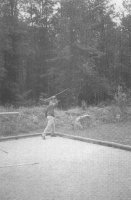
Throwing the spear
|
It is well worth going out of your way to visit Le Parc Pyrénéen, but you will need at least half a day to appreciate it fully. (Situation: route de Banat, 09400 Tarascon-sur-Ariège. Tel: 05 61 05 10 10. Fax: 05 61 05 19 19. Group rate 45FF).
Andrew J Lawson
Wessex Archaeology
|
|
OSTEOARCHAEOLOG1CAL
RESEARCH GROUP
|
|
Frank Bridgland has recently taken over as Honorary Secretary and publicist for ORG, and writes to remind/inform members of its existence. It was set up as a special interest group with the primary aim to bring together anyone (including those with no formal qualifications) who has an interest in or works with human and/or animal bones. ORG's aims are to provide a forum of exchange of views through the medium of newsletters (the quarterly ORGAN) and regular meetings. It is interested in providing careers advice and training, along with information on services for specialists and the consideration of standards for recording/reporting.
The editorial address of ORGAN is Lorrain Higbee, 56 Main Road, Collyweston, Stamford, Lincs PE9 3PQ. Lorrain would be happy to accept items of news, especially of ongoing work, short articles etc, in typescript or on disk. Subscription details are available from Lorrain or Frank himself, who will also answer enquiries on membership and related queries - but please enclose a stamped addressed envelope! Frank Bridgland, 7 Iden Cres, Staplehurst, Kent TN12 ONX.
|
|
A
NEW APPROACH TO THE ENGRAVING OF THE 'PETIT SORCIER À L'ARC MUSICAL'
IN THE TROIS FRÈRES CAVE, ARIÈGE
Following Andrew Lawson's piece about the book
Les Chamanes de Ia Préhistoire by Clottes and Lewis-Williarns in PAST
25, three students at the Laboratoire d'Anthropologie et de Préhistoire
des Pays de la Méditerrannée Occidentale in Aix-en-Provence, France,
wrote to Andrew about a study they had made of the engraving of the
'petit sorcier à l'arc musical', which he used in illustration of his
piece. Their study is published in Préhistoire Anthropologie Méditerranéennes
5, 1996, 35-37; they invited debate on their analysis, and Andrew suggested
that it could be followed in the pages of PAST To this end, I summarise
the main points of their study, and invite comments from readers.
|
|
Frederic Demouche, Ludovic Slimak and Daniel Deflandre set the scene with a description of the richly-decorated cave of Trois Frères, discovered by H. Begouën in 1914, and the engraving, which has been described as a 'composite' figure with human and animal attributes. Although this figure has sometimes been associated with two animal figures in front of it, the large number of animals depicted on this panel, which may not all be contemporary, makes the association somewhat tentative, and the authors restrict their study to the figure of the 'sorcier'.
They describe the previous 'classic' interpretation by Begouën and Breuil of this figure as a man-bison playing a musical bow of a type known in South Africa, or perhaps a wind instrument, and in a posture suggesting dance, considered as an act of Cynegetic magic. Clottes has agreed with this interpretation, and discusses it in the context of shamanism.
|

The "sorcier" engraving turned
on its side, with an imaginary line representing the ground surface.
|
The authors then discuss their new approach: first, if it is a 'sorcier' dancing upright, then surely the tail should hang down, following the line of the torso, rather than following the line of the raised thigh. Second, the arms are stretched out in front, and the extremities at no point touch the 'musical bow', hardly compatible with the playing of a musical instrument. These observations, plus an absence of a consistent horizontal plane in the panel, lead the authors to suggest that the figure can be best understood as being on four feet on the ground, represented by an imaginary line. This is supported, they believe, by the coincidence of the end of the bow with the same imaginary ground surface, and by the hunched back of the figure which would agree with the idea of the 'sorcier' as disguised and moving on four limbs. They admit that this reading puts this figure on a different horizontal plane from the majority of the animals on the panel, but think that it could be expressing the effect of depth. In association with other engravings on the panel, the 'sorcier' could represent a person skirting round game.
The authors then propose new ways of interpreting this engraving, though not tackling the question of its symbolic or magic value. The scene could represent a hunting technique, with the hunter dressed in an animal skin, in this case that of a bison; hunting game in disguise is well-documented ethnographically, and the authors use a modern drawing of a Lakota hunter turned through 90º to show a similarity with the posture of the 'sorcier' figure. This would allow the bow held in the mouth to be interpreted as a hunting bow rather than a musical instrument, the short hunting bow being known among American and circumpolar hunting groups.
The engraving, then, could be a realistic representation of hunting with the bow in the upper palaeolithic, and the authors address the question of archaeological evidence for such a technique at this period. They cite previous, though inconclusive, studies, and evidence for arrow points and for pieces of bone which might be part of composite bows. They believe that new interpretations of the archaeological material could be initiated through their study of this figure, and that other apparently enigmatic representations might be rendered more comprehensible.
|
|
CHAMPION'S
CHOICE
A regular column featuring the best of Prehistory
on the World Wide Web
|
|
Chetro Ketl Great Kiva: This site presents a three-dimensional
reconstruction of a Great Kiva, an architectural feature found in many
prehistoric Anasazi communities in the Southwestern United States. The
site can be visited and 'walked around' using the mouse to click on
the navigation buttons; those with Quicktime capability on their machine
can also experience a 'fly-through', an interactive movie, and movies
of Anasazi pottery.
 |
http://sipapu.ucsb.edu/html/kiva.html |
Hal Saflieni Hypogeum Website: An imaginative presentation by
the National Museum of Malta showing good views of the site and some
of the associated material, as well as information on the history of
its discovery and excavation. Until the Hypogeum is reopened after 5
years of restoration work, this is the only way of visiting the site!
 |
http://www.magnet.mt/home/museums/ |
neanderthal.de: Website des Neanderthal Museums, Mettmann: This
site has details of the museum, which was opened in October 1996, in
the form of an illustrated summary of the exhibition and of the building's
architecture. There are pages about the Neanderthal valley itself, and
links to other relevant websites; the 'Research' pages include a facility
for web publication of research by younger scholars in the form of longish
summaries of theses and dissertations, of which a number are already
accessible.
 |
http://www.neanderthal.de/ |
Kilmartin House Trust: This centre for archaeology and landscape
interpretation in Kilmartin Valley, Argyll, has produced an excellent
web-site which focuses on the rich archaeological landscape around Kilmartin.
included on-line are a section on prehistoric music (with sound), and
lists and a clickable map of local archaeological sites, many of which
are prehistoric. Each site is illustrated, and has a description and
details of excavations where relevant, publications, and access.
 |
http://www.kht.org.uk |
RockArtNet: Produced by the archaeological co-operative 'Footsteps
of Man', this is a key resource for worldwide rock art on the Web, with
links to other rock art organisations with a Web presence, and to a
number of excellent illustrated presentations of rock art in particular
areas. There is a bulletin board for discussion and announcements, and
a link to their on-line journal TRACCE, where current research is published.
They are also developing an iconographic database on-line.
 |
http://www.geocities.com/Athens/5806/index.html |
|
|
CONFERENCES
AND MEETINGS
|
|
Neolithic Studies Group meeting on Quarries and Mines: 9.5.98-10.5.98
This meeting in Cambridge will consider the social, symbolic and practical aspects of the extraction of raw material, the organization of labour, the perception of such industrial processes and landscapes during the Neolithic, and chronology. A field trip to Grimes Graves on the Sunday will discuss aspects of the site both on the surface and below the ground. Further details from Dave Field, RCHME, 24 Brooklands Ave, Cambridge CB2BU.
International Symposium on Woman in Prehistory, Today and Tomorrow:
25.6.98-27.6.98
This symposium explores a range of themes relating to women including
subsistence, technology, building, storage, cosmos and shrine, healing
and body decoration. In Istanbul and Konya, Turkey, it includes a feast
at Catalhoyuk. For further details contact Ceylan Orhun, Galip Dede
Caddesi 149/12 Beyogly, 80030 Istanbul,Turkey; tel: +(90) 212 293 6319,
fax: +(90) 212 245 52 20
 |
herana@superonline.com |
 |
http://acs.oakton.edu/~cichon/ |
Gibraltar and the Neanderthals: 28.8.98-30.8.98
The conference, celebrating the discovery of the Forbes Quarry skull
in 1848, will cover the palaeontological, archaeological and palaeoenvironmental
aspects of the Neanderthals, placing the Gibraltar finds in their European
and Mediterranean contexts. There will also be visits to relevant sites
in the region. Further details from Dr Clive Finlayson, Director, The
Gibraltar Museum, P0 Box 939, Gibraltar; tel +(350) 74289, fax +(350)
79158
 |
jcfinlay@gibnet.gi |
International Rock-Art Congress: 6.9.98-12.9.98
The 1998 IRAC meeting at the Universidade de Trás-os-Montes e Alto Douro
in northern Portugal. The theme, 'Crossing frontiers', aims to reveal
and explore the latest discoveries and emerging methods and techniques
in the study, conservation and presentation of. world rock art. Further
details from IRAC 98, Congresso Internacional de Arte Rupestre, Secção
de Geologia, UTAD, Apartado 202, 5001 Vila Real Codex, Portugal, tel
+(351) 59 32 0l 79, fax +(351) 59 32 61 46
 |
irac@utad.pt |
 |
http://www.utad.pt/actividades/IRAC |
Neolithic Orkney: 10.9.98-14.9.98
This conference will bring together a variety of opinions and views
about Orkney in the light of new theories and new discoveries and will
place Neolithic Orkney in a European context. There will be opportunities
for participants to take part in guided study tours on the Mainland
or to the Northern Isles. For further information please contact the
Conference Secretary Katherine Towsey, c/o Tankerness House Museum,
Broad Street, Kirkwall, tel 01856 873191 or 01856 870964
 |
113277.554@compuserve.com |
|

















